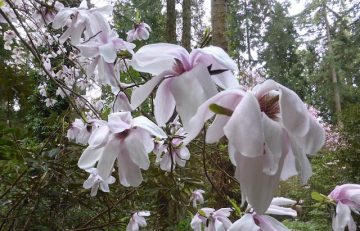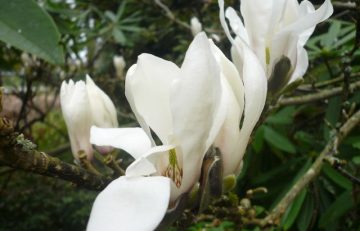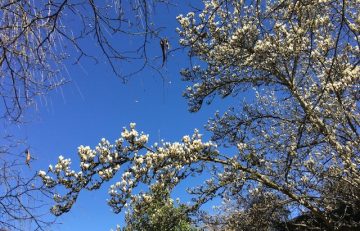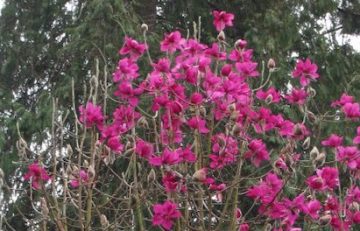
As I’ve written about before, March is a tricky month for floral predictions. Weather forecasts have gotten better over the years, but knowing with any certainty what’s coming more than two weeks ahead shouldn’t be a reasonable expectation at this time of year. We can all remember years when a long period of mild weather at this time is suddenly interrupted by an unexpected plunge into the deep freeze, just as flowers are opening. You may remember me recounting an infamous year when the International Magnolia Society visit followed hard on the heels of a particularly spiteful Arctic blast. All I remember is blacked buds.
Two weeks from now is March 15th. That date—remembered as the Ides of March—brought Julius Caesar bad luck (indeed, the very worst kind), but thankfully, killing frosts are rare by that time, in the Garden. And judging by the numbers of flower buds visible on our trees, 2025 will go down as one of the better years for large flowered magnolia flowers. Among the earliest magnolias to flower in the Botanical Garden, usually from early to late March, are species in the section Yulania (a section is a subdivision of a genus). The four sect. Yulania species listed below are usually reliably in flower in March. Of course, that’s just the beginning of the yulanias (April has much more in store for this group).
Magnolia zenii (Zen’s magnolia) is nearly always the first out of the gate with its masses of smallish vase-shaped, white-streaked-purple flowers that emerge from silvery buds. At the Garden we seldom talk about this species without mentioning conservation, as Zen’s magnolia is only known from a population of eighteen individuals on the north slopes of Baohua Mountain in the southern Chinese province of Jiangsu. Considered critically endangered in the wild, in 1980, seed was collected from these trees and distributed to botanical gardens around the world. We have three specimens, one by the Service Road Gate close to the David C. Lam Asian Garden entrance, one near where Kingdon Ward Way meets Upper Asian Way, and the third west of Kingdon Ward Way below Lower Asian Way.
Magnolia campbellii (Campbell’s magnolia) was first discovered by Europeans in 1855, in the Himalayas, but its range extends well into the mountains of southwestern China, where trees have somewhat hairier shoots and are a little hardier. The flowers of M. campbellii are the most symmetrical of all of the large deciduous Asiatic magnolia species. They can be up to 20 to 30 cm across when fully open, and are often described as having a cup-and-saucer arrangement. The Asian Garden boasts several seedlings and selections of M. campbellii, including a much-photographed specimen on Upper Asian Way just west of Staunton Trail that has lovely muted-pink flowers. A brighter-pink-flowered cultivar, ‘Sidbury’, is located off Lower Asian Way between Stearn and Cox Trails. ‘Borde Hill’ (near where Stearn Trail intersects Campbell Trail) has among the darkest magenta-purple flowers of any of the large-flowered magnolias. ‘Lanarth’ is another seedling selection, and much the same in appearance as ‘Borde Hill’ (both were seedlings derived from a wild collection in Myanmar), but does not flower as copiously as the former, at least in the Asian Garden.
The largest flowers of the yulania magnolias belong to Magnolia sargentiana (Sargent’s magnolia). This variable species is native to Yunnan and Sichuan in southwest China and is represented here by a number of garden-derived seedlings and selections. They are all readily distinguished by the ragdoll posture of their flowers and broad, irregularly drooping tepals. One of the earliest flowering in the Garden is the cultivar ‘Blood Moon’, which has rosy-pink flowers, the broad tepals darkening toward the base. A strongly upright grower, ‘Blood Moon’ produces its flowers high in the canopy. Out of the ten un-named M. sargentiana seedlings in the Asian Garden, the most spectacular, arguably, is the specimen located opposite the Moon Gate. The flowers on this tree are creamy white and not only huge, but borne on spreading branches, many at close to eye level. Another notable cultivar is M. sargentiana ‘Nymans’, which is visible from the northeast corner of Wharton Glade and produces opulent displays of flowers reliably, but later in March or in early April.
Close to M. sargentiana ‘Nymans’ is a pair of Magnolia sprengeri (Professor Sprenger’s magnolias). Both seedlings and cultivars (named selections) are scattered throughout the Asian Garden. The species hails from the mountains of central China and is considered the cold-hardiest of the large-flowered Asian magnolias. Prior to flowering, Magnolia sprengeri can also be recognized by the leaning posture of its large, fuzzy, yellowish-grey flower buds, but the species is generally recognized by its mostly upright, but asymmetrical flower buds and flowers, and its pink or rose pink tepals that are creamy white toward the inside. The open flowers usually produce a captivating wintergreen fragrance. Magnolia sprengeri var. diva—the most commonly grown form of the species, bears bright pink tepals. The second M. sprengeri tree in the Wharton Glade bed is ‘Claret Cup’, which has flowers that have rose-pink tepals. The largest and most impressive var. diva plant, however, is located at Upper Asian Way and Campbell Trail. Equally popular with visitors is the spectacular ‘Eric Savill‘. A garden seedling selection of var. diva, ‘Eric Savill’ bears extraordinary hot-pink-backed, rumpled tepals. The strong pink bleeds through to the inside, making the flowers, which are some 25 cm across, look like melting raspberry-ripple ice-cream. There are two specimens in the Garden. One is near the west end of the boardwalk by the Ting, and the other—a much slenderer, taller tree—at the west end of the parking lot. So, behold the Ides of March, when these magnolias are blooming. fd
- Magnolia campbellii with Rhododendron denudatum Sidbury
- Magnolia sprengeri Claret Cup
- Magnolia sargentiana
- Magnolia sprengeri Eric Savill
- Magnolia zenii
- Magnolia zenii
- Magnolia sprengeri diva
- Magnolia sargentiana Bloodmoon
- Magnolia campbellii Borde Hill
- Magnolia campbellii Sidbury
Submitted by: Douglas Justice, Associate Director, Horticulture and Collections at UBC Botanical Garden










